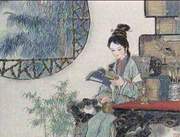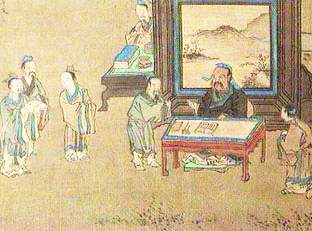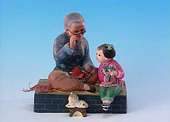 |
| History of Chinese Names |
 No one knows exactly how many surnames huge population in China shares. Rosters found among ancient Chinese documents give from 300 to 3,000. Most specialists in the field agree that the most common surnames of the Han Chinese number some 500. No one knows exactly how many surnames huge population in China shares. Rosters found among ancient Chinese documents give from 300 to 3,000. Most specialists in the field agree that the most common surnames of the Han Chinese number some 500.
Chinese surnames are believed to have originated during the prehistorical matriarchal society.This theory is supported by the Chinese character for surname, 姓(xìng). The character is a merger of two other characters: 女(nǚ)and生(shēng), meaning“born of woman”.
According to CRI reports, a modern Han Chinese name rarely has more than three characters-with the first character being the surname, and the second and third a connotative given name. This is very different from the way ancient Chinese names were formed. An ancient Chinese name often included four components: first the family name, followed by the given name, the alias, and then what's known as the “style”.
Take the name“Confucius” as an example. His surname in Chinese is孔 (kǒng). His given name丘(qiū)means hill. His alias is仲(zhòng)尼(ní), with 仲meaning the second son of the family and 尼 taken from the name of the hill尼丘, where his parents had prayed for his birth.
 In ancient China, one could be identified not only by the given name or the alias after the name, but also by the style. Although one had no choice of surname or given name, one could choose his own alias and style. According to the custom of the time, people chose their alias when they entered adulthood. This was a way of telling others that their course in life had changed and that they were now adults and moving toward their goals. People called one another by the alias as to show mutual respect. In ancient China, one could be identified not only by the given name or the alias after the name, but also by the style. Although one had no choice of surname or given name, one could choose his own alias and style. According to the custom of the time, people chose their alias when they entered adulthood. This was a way of telling others that their course in life had changed and that they were now adults and moving toward their goals. People called one another by the alias as to show mutual respect.
The term“style” in a Chinese name may not be familiar to you. It was used to denote a tribal society. But in time it became an honorary title which was awarded to brave military leaders or to show the nobility. Gradually, the style designation began to be used in a more general way. One category of styles was known as the Posthumous Style which was used to honor an emperor, a duke or a prince after death. As you may have guessed, these posthumous styles often used an inflated vocabulary to praise the ruling class. Once again, let's turn to Confucius as our example. He had no less than ten of these honorary titles or styles. Through the long course of Chinese history, he has been given such titles as Supreme Mentorand, Divine Master of Glory. Today, you can visit the Confucius Temple at his birthplace, the town of Qufu in East China's Shandong Province. There you can read through a long list of these glorifying styles or titles. Each seems grander than the one before. Finally, you will see the name by which we know him today, simply“Confucius”or“孔子”(kǒng zǐ) in Chinese, “孔”being his family name and “子” being an ancient title of respect for a learned or virtuous man .
 The May Fourth Movement in 1919, brought with it what was known as the “Vernacular Campaign”. This was a period of drastic change in the Chinese language. Classical tradition began to yield to the much less formal culture of the vernacular. And this soon influenced Chinese names. A Chinese name used to be called 学名(xué míng), meaning academic name. It implied learning and wisdom. But the Vernacular Campaign saw all sorts of characters being used to form a person's name. Then after the founding of New China in 1949, names began to take on a political touch. Parents chose names for their children which would almost like slogans-names such as“爱国”(ài guó)which means love the country, or“爱党”(ài dǎng) meaning love the Party. This practice reached its peak during the Cultural Revolution, when many parents gave their children names like“爱东”(ài dōng), which translates as“Love Chairman Mao Zedong”,or“国庆”,which means National Day Celebration. Other favorite words entering the vocabulary of names included: red, revolution, soldier, guard, army, and east. Today, when you look through a telephone book, you can tell approximately when persons were born by their names. The May Fourth Movement in 1919, brought with it what was known as the “Vernacular Campaign”. This was a period of drastic change in the Chinese language. Classical tradition began to yield to the much less formal culture of the vernacular. And this soon influenced Chinese names. A Chinese name used to be called 学名(xué míng), meaning academic name. It implied learning and wisdom. But the Vernacular Campaign saw all sorts of characters being used to form a person's name. Then after the founding of New China in 1949, names began to take on a political touch. Parents chose names for their children which would almost like slogans-names such as“爱国”(ài guó)which means love the country, or“爱党”(ài dǎng) meaning love the Party. This practice reached its peak during the Cultural Revolution, when many parents gave their children names like“爱东”(ài dōng), which translates as“Love Chairman Mao Zedong”,or“国庆”,which means National Day Celebration. Other favorite words entering the vocabulary of names included: red, revolution, soldier, guard, army, and east. Today, when you look through a telephone book, you can tell approximately when persons were born by their names.
Another obvious change in Chinese names is that many people now use only two characters. A study shows that, before 1966, about 90 percent of Chinese names had three characters. Except for a temporary lapse during the Han Dynasty, this three-character tradition continued unbroken. The survey shows that about half of today's younger generation in China have two-character names.
Nowadays, Chinese names show characteristic styles. Some kids even gain four-character names in order to be outstanding and uncommon among others.
|
|
|













